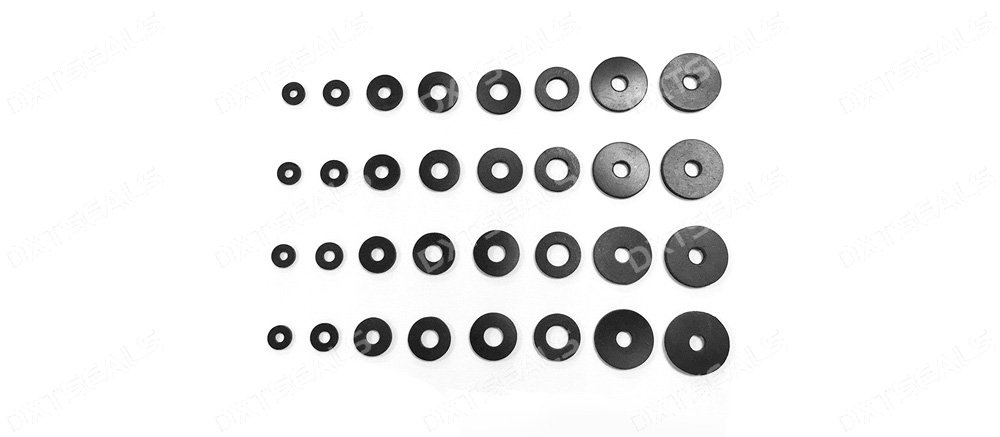
Rubber gaskets are essential components in hydraulic systems, providing reliable sealing under high pressure and in the presence of various fluids. Among their most critical properties is oil resistance, which ensures optimal performance and longevity. This article delves into the oil-resistant characteristics of rubber gaskets, the materials that enhance their performance, and their indispensable role in hydraulic systems.
Key Properties of Oil-Resistant Rubber Gaskets
Rubber gaskets are specifically engineered to withstand exposure to oils and other hydraulic fluids. Their oil resistance is determined by the material composition and design. Key properties include:
1. Resistance to Swelling and Deformation
Exposure to oils can cause some materials to swell, deform, or degrade. Oil-resistant rubber gaskets maintain their structural integrity, ensuring a secure seal even under prolonged exposure.
2. High-Temperature Tolerance
Hydraulic systems often operate at elevated temperatures. Oil-resistant gaskets are designed to withstand these conditions without losing flexibility or sealing capability.
3. Durability Against Fluid Compatibility
Hydraulic systems use various fluids, including mineral oils, synthetic oils, and water-glycol solutions. Oil-resistant gaskets are formulated to resist chemical degradation across a wide range of fluids.
4. Compression Set Resistance
Rubber gaskets must maintain their shape and sealing properties under continuous compression. Oil-resistant materials minimize permanent deformation, ensuring long-term reliability.
Common Materials for Oil-Resistant Rubber Gaskets
The choice of material plays a pivotal role in determining the oil resistance of rubber gaskets. Common materials include:
1. Nitrile Rubber (NBR)
- Features: Exceptional oil and fuel resistance, good mechanical properties.
- Applications: Widely used in hydraulic systems, automotive engines, and fuel systems.
2. Fluorocarbon Rubber (FKM/Viton®)
- Features: Superior resistance to high temperatures and aggressive oils.
- Applications: Suitable for extreme conditions in aerospace, chemical processing, and heavy machinery.
3. Hydrogenated Nitrile Rubber (HNBR)
- Features: Enhanced heat and oil resistance compared to standard NBR.
- Applications: Ideal for modern hydraulic systems and oilfield equipment.
4. Ethylene Propylene Diene Monomer (EPDM)
- Features: Moderate oil resistance, excellent resistance to water-based hydraulic fluids.
- Applications: Used in hydraulic systems with water-glycol solutions.
5. Polyurethane (PU)
- Features: High wear resistance and good oil compatibility.
- Applications: Used in dynamic sealing applications within hydraulic systems.
Role of Rubber Gaskets in Hydraulic Systems
Rubber gaskets serve several critical functions in hydraulic systems, ensuring smooth and efficient operation.
1. Preventing Fluid Leaks
Gaskets create a secure seal between components, preventing hydraulic fluid from leaking. This maintains system pressure and efficiency.
2. Reducing Wear and Tear
By providing a buffer between metal components, rubber gaskets minimize wear caused by vibration and movement.
3. Enhancing System Reliability
Oil-resistant gaskets ensure consistent performance even under high pressure, reducing the risk of system failure.
4. Improving Safety
Proper sealing prevents fluid leaks that could lead to hazardous conditions, such as reduced system performance or fire risks.
Applications of Oil-Resistant Rubber Gaskets in Hydraulic Systems
Oil-resistant rubber gaskets are found in a variety of hydraulic applications, including:
1. Hydraulic Pumps and Valves
- Ensuring precise sealing in high-pressure environments.
- Maintaining fluid integrity and system efficiency.
2. Cylinders and Actuators
- Providing reliable sealing for pistons and rods, enabling efficient motion control.
3. Reservoirs and Tanks
- Preventing leaks in fluid storage components.
4. Connectors and Hoses
- Ensuring tight seals in hydraulic hose fittings and connectors.
5. Industrial Machinery
- Used in presses, cranes, and other hydraulic-driven equipment to maintain optimal performance.
Advantages of Oil-Resistant Rubber Gaskets in Hydraulic Systems
The use of oil-resistant rubber gaskets offers numerous benefits:
- Enhanced Longevity: Resistant to oil degradation, ensuring a longer service life.
- Improved Efficiency: Reliable sealing minimizes fluid loss and maintains system pressure.
- Cost Savings: Durable materials reduce maintenance and replacement costs.
- Versatility: Compatible with a wide range of hydraulic fluids and operating conditions.
Tips for Selecting the Right Oil-Resistant Rubber Gasket
Choosing the appropriate gasket for a hydraulic system depends on several factors:
1. Fluid Compatibility
Ensure the gasket material is compatible with the hydraulic fluid used in the system.
2. Operating Temperature
Select a material that can withstand the temperature range of the application.
3. Pressure Requirements
Consider the pressure rating of the gasket to ensure it can handle system demands.
4. Application Environment
Account for factors such as vibration, dynamic motion, and exposure to chemicals or UV radiation.
5. Customization Options
For unique requirements, consider custom-manufactured gaskets tailored to specific dimensions and conditions.
Conclusion
Rubber gaskets with oil-resistant properties are vital for the efficiency and reliability of hydraulic systems. By selecting the right material and design, industries can ensure optimal sealing performance, reduce maintenance costs, and enhance safety. From NBR to FKM, the choice of material should align with the specific operating conditions and fluid compatibility of the system.
Investing in high-quality oil-resistant rubber gaskets is not just about sealing—it’s about ensuring the smooth and uninterrupted operation of hydraulic systems in diverse industrial applications. For expert guidance and customized solutions, consult a trusted gasket manufacturer.
